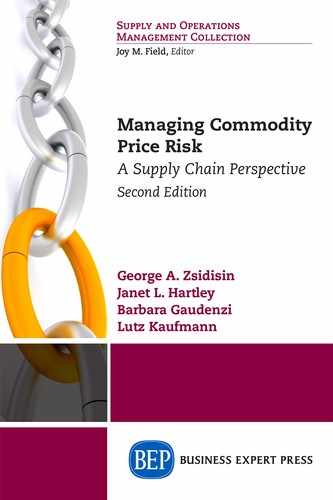Accuracy, short-term commodity prices, 41–43
Arbitrage, 70–71
Asian calls and puts option, 121–122
Building-in financial slack, 77–78
Call option, 120–121
Calls and puts option, 120–121
Collar approach, 125–126
Collar with knock-in (KI) approach, 126–127
Commodities as collateral, 112–113
Commodity-based financing, 112–113
Commodity price analysis, 8–9
Commodity price fluctuations, 6
Commodity price-risk appetite, 21
Commodity price volatility
creating value from, 6–10
downside of, 5–6
Commodity swap, 123–124
Commodity traders, 33
Correlations, 63–69
Cross-hedging, 84–85
De-escalation clause, 95–98
Demand
basics of, 59–60
factors affecting, 60–63
Direct commodity purchase
building-in financial slack, 77–78
characteristics and approaches, 75–77
cross-hedging, 84–85
financial hedging, 80–84
forward buying, 78–79
improving product/production designs and systems, 85–86
staggering contracts, 79–80
substitution strategy, 86–89
switching suppliers, 80
Dow, Charles, 29
DuPont model, 7
Escalation clause, 95–98
Financial hedging, 80–84
Firm fixed-price contracts, 93–94
Forecast accuracy, 41–43
Forecast error, 41
Forward buying, 78–79
Fundamental analysis process. See Long-term commodity prices, forecasting
Future prices, 69–71
Heavy rare earth metals (HREM), 103–106
Hedging, 17, 127–132
Hedging structures
non-plain vanilla structures, 124–127
plain vanilla structures, 120–124
Historical commodity price data, 30
HREM. See Heavy rare earth metals
Internal spend analysis, 15–18
International Institute for Sustainable Development, 3
Linear regression models, 38
Long-term commodity prices, forecasting
correlations, 63–69
demand basics, 59–60
developing and monitoring, 71
factors affecting demand, 60–63
factors affecting supply, 55–59
future prices, 69–71
gathering information, 48–51
regression models, 63–69
supply basics, 51–55
MAD. See Mean absolute deviation
MAPE. See Mean absolute percent error
Mean absolute deviation (MAD), 43
Mean absolute percent error (MAPE), 43
Mean forecast error (MFE), 42
MFE. See Mean forecast error
Non-plain vanilla structures, 124–127
OPEC. See Organization of the Petroleum Exporting Countries
Organizational dependence, 15–18
Organizational price risk exposure, 14–15
Organization of the Petroleum Exporting Countries (OPEC), 54
Pearson correlation coefficient, 65
Piggyback contracting, 94–95
Plain vanilla structures, 120–124
Political risk
heavy rare earth metals-case study, 103–106
practical implications, 106–108
Price patterns
identifying, 31–33
seasonal, 40–41
stable, 34–38
with trends, 38–40
Price risk exposure
dependence, 15–18
organization, 14
overall estimate, 14–15
Price volatility
creating value from, 6–10
determine degree of, 18–20
downside of, 5–6
Product price flexibility, 23
Regression models, 63–69
Risk appetite analysis, 21
Risk aversion, 20
Risk objectives, setting, 21–23
Risk tolerance, 20–21
Seasonal price indices, 40
Seasonal price patterns, 40–41
SFCs. See Synthetics forward contracts
SFCs with knock-in (KI) approach, 125–126
Short-term commodity prices, forecasting
accuracy, 41–43
historical commodity price data, 30–31
improving forecast, 43–44
monitoring forecast, 44
price patterns, identifying, 31–33
price patterns with trends, 38–40
seasonal price patterns, 40–41
selecting forecasting model, 33–34
stable price patterns, 34–38
Simple exponential smoothing model, 36
Spot prices, 30
Stable price patterns, 34–38
Staggering contracts, 79–80
Stocks-to-use ratio, 68
Substitution strategy, 86–89
Supply
basics of, 51–55
factors affecting, 55–59
Supply chain managers, 33
Switching suppliers, 80
Synthetics forward contracts (SFCs), 122–123
Technical analysis process. See Short-term commodity prices, forecasting
Time-series models, 34
Trend-adjusted exponential smoothing, 38
U.S. Department of Agriculture Economic Research Service, 31
Value chain purchase
characteristics and approaches, 91–93
escalation/de-escalation clauses, 95–98
firm fixed-price contracts, 93–94
improving product/production designs and systems, 98–99
piggyback contracting, 94–95
vertical integration, 99–100
Value creation, price volatility, 6–10
Vertical integration, 99–100
